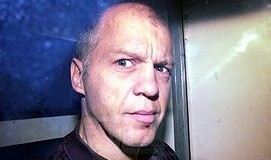The exact motive for the murders of Lin and Megan
Russell may never be known but the killings appear to be linked with
Michael Stone's addiction to heroin.
Stone, who was unemployed, spent much of his time
scouring Kent for goods which he could steal and sell to finance his
£100-a-day drug habit.
The second trial heard that a bootlace found near the
murder scene bore all the hallmarks of the type used by drug addicts as
a tourniquet.
Forensic scientist Rodger Ide said the 99cm lace had
three knots tied in it.
Injected several times a day
Stone was a drug user who injected heroin five or six
times a day.
Some said they saw him use shoelaces, belts and a tie
as tourniquets to bring up his veins.
The black, braided lace was found near a copse on
Cherry Garden Lane.
If the lace was his it is not clear if he was "shooting
up" before or after the murders.
Stone, who was born Michael John Goodban in Tunbridge
Wells in 1960, was one of five children.
His building labourer father split up with his
mother, who has married a total of four times, but not before Stone
witnessed and suffered domestic violence as a child.
Confused and angry teenager
The young Stone ended up in a children's home in
Eastry, near Canterbury, but he was abused and embarked on his teenage
years as a confused, frustrated and angry boy.
When he was released from care he moved to Gillingham
and took up a heroin habit.
He had a police record dating back to the age of 12
and his criminal career - mainly shoplifting and burglary - continued
unabated into adulthood.
In 1981 he was jailed for two years at Middlesex
Crown Court for robbery and grievous bodily harm after he attacked a
homosexual man with a hammer.
Two years later he was sentenced to four-and-a-half
years for wounding, assault and dishonesty after he stabbed his sleeping
victim in the chest with a kitchen knife.
Freed in 1993
In 1987 he was jailed again, this time for an armed
robbery on a building society in Brighton which netted him a measly
£577.
Stone was jailed for eight years and walked free in
1993.
Despite the resurgence of his drug habit, he was able
to keep out of trouble with the law until that fateful day in July 1996.
Stone admitted he had been taking so many drugs that
he had no idea where he was on the day of the murders.
In interviews after his arrest Stone repeatedly
denied killing Dr Russell and her daughter but admitted he had no alibi.
The trial was told that Stone supplemented his income
by driving around Kent and stealing lawnmowers, mobile generators, hi-fi
equipment and other easily disposable goods.
One friend said he knew the Chillenden area "like the
back of his hand".
'He wanted money'
Josie Russell, who was left for the dead in the
attack, later told police a man had demanded money from them before
tying them up and bludgeoning them with a hammer.
Stone admitted: "I haven't got an alibi."
Detectives asked him: "You had no idea at all where
you were on that day?"
Stone said: "I can't remember. I can't remember for
two reasons. One - I was badly on drugs and two - it was so long ago."
He told detectives that he had been a heroin user for
years.
Before Stone's arrest the man heading the inquiry,
Detective Chief Inspector Dave Stevens, speculated on what might have
been going on in the killer's head.
He said: "Maybe he's got a down on stable families.
This young family walking through the cornfield with their dog. Maybe he
thought 'This is everything I want and I can't have it'."

